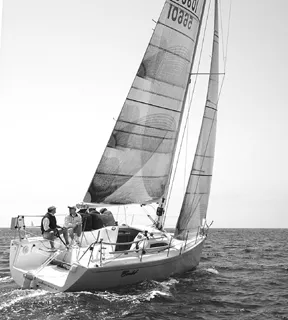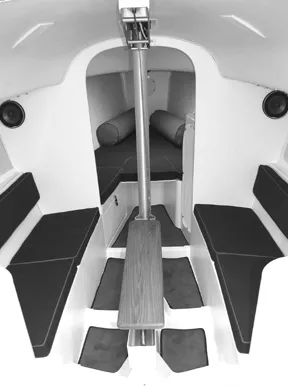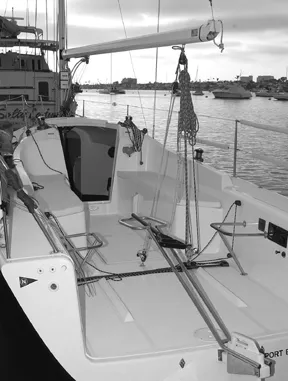The Columbia 30 is being constructed and marketed by Columbia Yachts under the direction of Vince Valdes, son of Dick Valdes, who formed the original Columbia Yacht company in 1958. At age 25, Valdes the elder, partnered with Maurice Thrienen to form Glass Laminates for the purpose of building fiberglass sailboats. To satisfy investors’ needs to keep cash rolling in, they also built fiberglass camper tops, shower stalls, and chemical toilets. The company’s name was eventually changed to Glass Marine Industries and, with the introduction of the Sparkman & Stephens designed Columbia 29, to Columbia Yachts.
A decade later, the company was the country’s largest fiberglass sailboat manufacturer, having produced over 30,000 sailboats. Early Columbia models included the Columbia 24 and Columbia 29, and designs produced by the likes of Bill Tripp, Alan Payne, Bill Crealock, and Charley Morgan. By 1964, the corporation was generating over $2.5 million in revenues per year and growing.

Valdes and his partners eventually sold the company. It endured several other owners before going out of business in the mid ’80s.
The new Columbia Yacht Corporation was incorporated in 2001 by the younger Valdes and partner Justin Wallin. The elder Valdes—an investor—has been involved since then, and typically spends an afternoon a week at the plant in Fullerton, CA.
Design
“We took a careful look at the state of sailing today,” explained Vince Valdes, “and we found something missing. There are some wonderful boats on the market—boats that are quick…boats that are agile…boats that are comfortable…boats that are comparatively inexpensive—but to date no builder has delivered a vessel that successfully incorporates the best of these elements for the sailing enthusiast.”
That was the company’s charge to designer Tim Kiernan (of Morrelli-Melvin) when the duo decided to proceed into production.
“The Columbia 30 is a unique sportsailer,” said Valdes, “designed for club racing, buoy racing, and pleasure sailing. Unlike others, it will merge the three guiding principles of Columbia Yachts: high performance, high comfort and ease of use, and high value.”
Valdez told us that boats from his resurrected company will “bridge the gap between heavy cruisers and impractical racers. Columbia Yachts will be designed to deliver practicality and enjoyment while not sacrificing the thrill and natural beauty of sailing, and of sailboats.”
Based on performance ratios, this 30-footer will cover a lot of water in a short period of time (PS calculated her SA/D at 27.92, and D/L at 86.88), and should be faster than most production-built 30 footers.
At first glance, these numbers define a typical plumb-bow, reverse-stern sailboat with a fine entry, tall rig, and open cockpit. But Kiernan explained that “side by side with a vintage Columbia, one can see the family resemblance, a re-invented bubble-top (cabintop), and distinctive bullet window” constructed of polycarbonate. Below the waterline, her hull is designed to plane, and the rudder and keel are both high-aspect-ratio sections.
A closer look is more revealing.
The rudder, for example, is transom hung in a carbon-fiber cartridge that allows it to be easily removed at the end of day and stored in a bag, while the stainless-steel tiller remains in place. Underway, the skipper is expected to steer while seated on the side deck with feet braced on a stainless footrest that provides a better toehold than a fiberglass brace (but both can trip a crewmember).
The forward half of the cockpit, however, is constructed with proper seats and seatbacks that are ergonomically shaped to be comfortable and provide adequate back support.
Most builders of production boats distain locating the mainsail traveler anywhere but on the cabintop. In contrast, this boat’s mainsheet moves on a traveler secured to the cockpit sole well aft, producing better sheeting angles at the end of the boom without, we think, sacrificing comfort or ease of movement once owners get accustomed to its location.
And, a 9.1 hp Yanmar diesel sail drive is located in a water-tight box beneath the cockpit sole. This means engine inspection, service, and removal are easily accomplished outside the main cabin (even with the boat in the water). Beyond that, this arrangement reduces engine noise belowdecks to a whisper, and eliminates odors. Bill Crealock’s boats are the only others we’ve seen that incorporate this sensible idea. Another plus is that the lower unit is fitted with a Martec, two-blade folding propeller that reduces drag.
But can a 30-footer really be trailerable? Hull No. 1 was introduced at the Annapolis Boat show last fall, 56 hours after the builders departed Los Angeles with the boat in tow behind a Ford Expedition.
On Deck
The Columbia 30’s deck layout was clearly designed with racing in mind, but almost anyone will find managing the sail controls a simple chore.
Of note is that the mast is a 42′-tall, carbon-fiber section constructed by Southern Spars with a double set of swept spreaders, eliminating the need for a backstay. Fortunately, the price of carbon fiber is on the decrease, so more builders are including carbon spars as standard equipment. However, Valdes says “the boom is aluminum because using carbon here doesn’t produce enough weight savings to offset the expense.” The boom is built by LeFiell of Santa Fe Springs, CA, and fitted with two internal reef lines. This mast-boom combination will safely carry the loads imposed by the sails, while reducing heeling and improving windward performance.
Minor details on the 30 display the builder’s intent to produce a high-quality product: for example, Lewmar genoa cars that are designed specifically for use only to port or starboard tilt outboard, avoiding contact with gelcoat and ports. The coaming is part of the deck structure, and it protects 60″-long benches with high backrests, but disappears aft where the helmsperson is intended to sit. Tapered stanchions are can’ted outboard, so they provide a safety net without impeding movement fore and aft. They are secured in a carbon-infused deck section and fitted with backing plates to withstand the weight of bodies falling on the lifelines.
Unlike lockers that compromise living quarters, the one on this boat is on centerline under the cockpit sole. It offers room for a six-man liferaft and has built-in chocks to which an anchor may be secured. The engine/locker structure is part of the hull structure, which eliminates flexing of the sole. Hull No. 1 was fitted with a bladder tank that has since been replaced by a fiberglass tank located to starboard of the engine. The tank, which can be easily removed for filling on a dock, is attached to a pump.
Two items we particularly like: The bilge pump is located in the cockpit to port; its handle disappears when not in use, and pops out when needed. It’s nice to have this safety feature close at hand, but out of the way. And dropping the rudder into a cassette is significantly easier than attempting to marry pintles to gudgeons with a six foot blade; and it can easily be lifted for ramp launching or clearing debris.
Belowdecks
The tradeoffs for having a large, functional cockpit, are minimalist spaces belowdecks. On paper, the accommodations appear to be comparable to many 30-foot racer/cruisers: there’s a saloon with a dining table, stove and sink, V-berth, two quarterberths, and a head. In reality, headroom is only 5’ 6″ when the companionway cover is closed, and the table will seat just four adults whose knees may touch the keel trunk with their feet resting in small, carpeted footbeds.

The settees are 55″ long, with 21″-wide seats, so they’re adequate for most adults to sit upright. A nice touch is that the seats are can’ted downward so they provide excellent support under the legs, and the seatbacks are angled slightly outboard. When the casual sailor props his legs on the table, the combination resembles an easy chair, albeit with a different level of comfort.
A portable, gimbaled one-burner stove lives in a fiberglass pod to port, and a small sink sits in a twin one to starboard. Absent a chart table, the stove or sink covers are the best alternatives for a nav station, though instruments can be housed in the vertical wall of the pod to starboard.
The most generous spaces are in the V-berth (8′ long) and quarter berths (8′ long and 36″ wide), below which are storage areas. Surprisingly, we were able to sit athwartships in the quarterberths without banging our head. There’s no ventilation in these berths, though cockpit ports are an option. Nor are reading lights included in the standard package.
Stowage here is unusual. Principally, it consists of four watertight boxes located under both settees. If used for dry goods, these are adequate for weekend provisions; if used for cold storage and filled with ice, a pump attached to the sink is designed to evacuate water. The arrangement is comparable to that used by campers. There’s additional storage below the quarterberths, and in a hanging locker forward that is enclosed by mesh cloth, allowing wet gear to breathe.
The head is a Jabsco handpump model attached to a 9-gallon holding tank located under the V-berth, but it’s not enclosed except for a fabric curtain that can cordon off the V-berth area.
Two important appendages—a retractable bow pole and the keel—take much of the living areas. The keel is a thin, aerodynamic section constructed of multiple layers of carbon fiber, to which is attached a 1,400-lb. bulb. Hoisting the keel is a simple matter of cranking a handle attached to a lifting winch affixed to the bottom of the mast compression post to conceal its presence. A 42:1 gear ratio eases the chore, but extends to 10 minutes the time necessary to complete the task. Given the choice, we’d find a way to install an electric motor. However, it’s nice that the drive is a worm gear, so if the handle is released, the keel remains locked in place.
A second impediment to crew comfort is the retractable bow pole, which is housed on centerline and intrudes well into the V-berth when retracted. Valdes explained: “When you’re at anchor, it can be pulled out to free up the space,” which assumes it won’t get entangled with other boats. Because it sits below the deck hatch, there’s a risk of someone inadvertently stepping onto the retracted pole if the hatch is open. Valdes countered: “It’s strong enough that it will not break,” so the major risk is injury.
The bow pole’s housing in the collision bulkhead is constructed of E-glass, producing a watertight compartment; water coming aboard when the pole is retracted drops into this box, and drains overboard.
Our take on living spaces is this: just as many Catalina owners say, “This ain’t a Hinckley,” so will Columbia 30 owners say, “This ain’t a Catalina.” Spaces belowdecks offer the essential amenities necessary for weekend cruising, and certainly more than those found on similar sized speedsters like the Santa Cruz 27 or Hobie 33; but, they will not satisfy owners accustomed to full head and leg room in the saloon, nor those who require much horizontal space in the galley and nav station.
Performance
We were less than five minutes into our test sail when it became clear that the Columbia 30 is a sailboat which will appeal to those for whom sailing performance is the most critical ingredient in a boat.
We sailed away from the dock in three knots of wind. Sailing in a harbor surrounded by buildings, we had only 4 to 6 knots of wind and flat water. In those conditions, this boat still moved at 4.5 to 5.5. knots, and accelerated immediately to 6 or 6.5 knots when puffs hit 7 knots. The boat coasted at 3 knots when the wind was entirely blocked by a building. And when a Mason 43 daysailer appeared on the water, the Columbia easily sailed over and past the larger vessel.
Her standard suit of sails includes a mainsail and 90% jib; it is unlikely that owners will need an overlapping headsail. Valdes said, “The square-top mainsail adds 60 sq. ft. of canvas and is the equivalent of adding six feet to the height of the mast.” This is an inexpensive method of adding horsepower, and is especially appropriate for boats destined to reside in light-air venues. With this configuration, the 30 heels quickly in the puffs, but having the mainsheet close at hand makes those situations easy to manage. “She is happiest sailing with 15 degrees of heel,” said Valdes.

We would have preferred to have more breeze to substantiate our impressions, but odds are that the mainsail will need to be reefed when winds exceeds 15 knots. So sailors in San Francisco and other heavy-air locales would likely start the day with a reef tucked in. “Shortening sail makes more sense than building a shorter mast,” said Valdes, explaining the company’s choice of sailplan.
Conclusion
As most major production builders continue introducing slightly tweaked versions of carbon copies of carbon copies, it’s refreshing to see a sailboat like the Columbia 30 that is a departure from the norm. But this may be more of a mainstream boat than it appears at first glance. The boat sails well; is reasonably well-equipped; has a large cockpit that—with the addition of a folding table, would provide a comfortable lounging area—and the tiller does not impinge on crew seating areas. Plus, engine location and access are excellent.
Certainly this boat has its shortcomings for those who would care to sleep on board. There are only two means of ventilating the interior (forward hatch and companionway, and though the berths are large enough for adults, the interior seating is marginal, while the galley is barely adequate for those who like to prepare food on board. And the bowpole’s centerline location impinges on room in the V-berth. Also, a solid door to enclose the head would be nice as an option.
Elsewhere, the cabintop has no handrails (they’re optional), and PS feels that the toerail should be extended aft for offshore sailing. Other than that, we’re sure that most owners will want to add deck cleats.
However, those drawbacks don’t diminish the boat’s sailing prowess, and we applaud the sensible ideas of an accessible engine that won’t stink up the interior, along with a retractable keel and rudder.
At present, the company has no dealers, so it offers boats at $89,900, a 20% discount from the list price. Is that a bargain? In comparison, a new J/105 (albeit larger with a more accommodating interior) lists at $189,000, and the trailerable Seaward Eagle 32 with a retractable keel is priced at $107,500, but neither can compare to the Columbia 30 in performance.
Potential buyers who are intimidated or put off by the 30’s appearance (stainless-steel tiller and footrests, tall rig, etc.), will be missing a chance to own a vessel that’s more like a BMW than a Chevrolet, but still provides a moderately comfortable—though admittedly spartan—place in which to “camp.”
Contact – Columbia Yachts, 714/ 773-9212, www.columbiayachts.com.
Also With This Article
“Columbia 30 in Context”
“Construction”
































